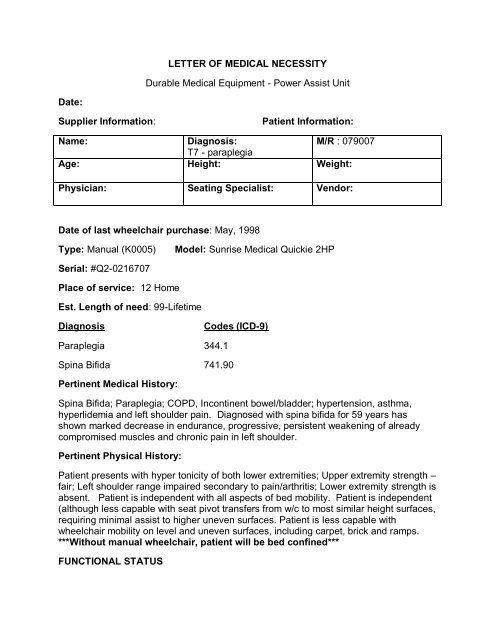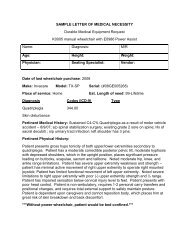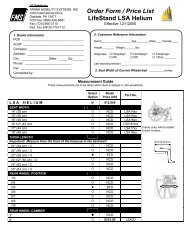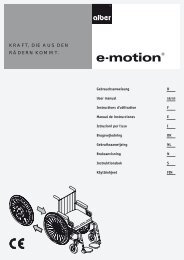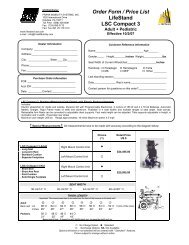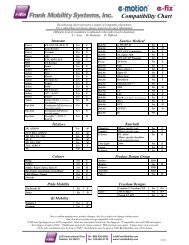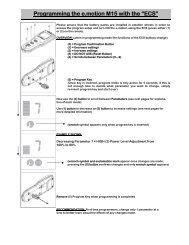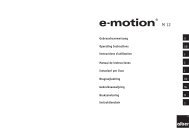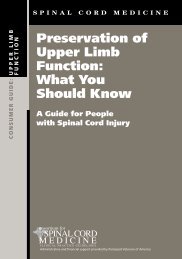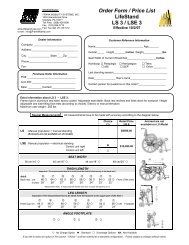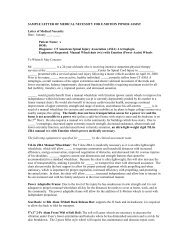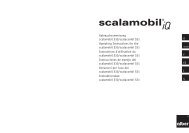letter of medical necessity 2 - Frank Mobility Systems
letter of medical necessity 2 - Frank Mobility Systems
letter of medical necessity 2 - Frank Mobility Systems
You also want an ePaper? Increase the reach of your titles
YUMPU automatically turns print PDFs into web optimized ePapers that Google loves.
LETTER OF MEDICAL NECESSITY<br />
Durable Medical Equipment - Power Assist Unit<br />
Date:<br />
Supplier Information:<br />
Patient Information:<br />
Name:<br />
Diagnosis:<br />
M/R : 079007<br />
T7 - paraplegia<br />
Age: Height: Weight:<br />
Physician: Seating Specialist: Vendor:<br />
Date <strong>of</strong> last wheelchair purchase: May, 1998<br />
Type: Manual (K0005)<br />
Model: Sunrise Medical Quickie 2HP<br />
Serial: #Q2-0216707<br />
Place <strong>of</strong> service: 12 Home<br />
Est. Length <strong>of</strong> need: 99-Lifetime<br />
Diagnosis<br />
Codes (ICD-9)<br />
Paraplegia 344.1<br />
Spina Bifida 741.90<br />
Pertinent Medical History:<br />
Spina Bifida; Paraplegia; COPD, Incontinent bowel/bladder; hypertension, asthma,<br />
hyperlidemia and left shoulder pain. Diagnosed with spina bifida for 59 years has<br />
shown marked decrease in endurance, progressive, persistent weakening <strong>of</strong> already<br />
compromised muscles and chronic pain in left shoulder.<br />
Pertinent Physical History:<br />
Patient presents with hyper tonicity <strong>of</strong> both lower extremities; Upper extremity strength –<br />
fair; Left shoulder range impaired secondary to pain/arthritis; Lower extremity strength is<br />
absent. Patient is independent with all aspects <strong>of</strong> bed mobility. Patient is independent<br />
(although less capable with seat pivot transfers from w/c to most similar height surfaces,<br />
requiring minimal assist to higher uneven surfaces. Patient is less capable with<br />
wheelchair mobility on level and uneven surfaces, including carpet, brick and ramps.<br />
***Without manual wheelchair, patient will be bed confined***<br />
FUNCTIONAL STATUS
Sitting Balance: Fair – sits with arm support<br />
Upper Ext. Function: Upper extremity status – Shoulder pain restricts him from<br />
elevation <strong>of</strong> his right arm and shoulder.<br />
Transfers: Independent<br />
W/C <strong>Mobility</strong>: Uses manual wheelchair<br />
Daily W/C Use: 7 hour per day<br />
Ambulation: Non-Ambulatory<br />
ADL: Independent; minimum assist with hand control<br />
Living environment: accessible home<br />
Current Equipment: Quickie 2HP<br />
Serial #: Q2-0216707<br />
Age <strong>of</strong> Equipment: 8.0 years old<br />
Problems with Current Equipment:<br />
Current quickie 2HP folding frame and seating are structurally sound. Totally nonambulatory,<br />
upper neuromuscular extremities have weakened to the point that patient is<br />
becoming less and less capable <strong>of</strong> self-propelling his 28.00 lbs Quickie 2HP either in his<br />
residence or around his neighborhood. Without some form <strong>of</strong> power assisted mobility,<br />
Patient soon will no longer be able to move unassisted around his residence attending<br />
to his activities <strong>of</strong> daily living. Patient’s psychological well-being may also suffer from<br />
the ensuing inactivity, isolation and increased dependence on others.<br />
The appropriateness <strong>of</strong> a traditional powered wheelchair is in this case unclear given<br />
patient’s particular condition and architectural layout <strong>of</strong> his home. Some form <strong>of</strong><br />
exercise is also in this <strong>medical</strong> best interest given his long-standing pharmacological<br />
treatment. The recommended E-motion power assist wheels, in this respect,<br />
supplement rather than eliminate the pushing stroke <strong>of</strong> a manual wheelchair.<br />
The following recommendation <strong>of</strong> durable <strong>medical</strong> equipment is found to be the most<br />
cost effective system to meet this patient’s postural support and mobility needs and it is<br />
made with recognition <strong>of</strong> this patient’s potential for growth and/or change.
PRESCRIBED MANUAL MOBILITY and SEATING SYSTEM:<br />
<br />
<br />
<br />
Emotion M15 Power Assist Drive Wheels<br />
24” Mag Rear wheels with Pneumatic Airless Insert Tires (durable and<br />
maintenance free for multi-use environments; composites allow for easier<br />
propulsion and durability)<br />
Rear Anti-tippers (safety; prevent rearward flipping <strong>of</strong> wheelchair going up<br />
various surface grades)<br />
The above recommendations were made after careful considerations <strong>of</strong> this<br />
patients needs. Please do not hesitate to call if you need further assistance.<br />
Your prompt attention to this matter would be greatly appreciated.<br />
Submitted,<br />
____________________<br />
Seating & <strong>Mobility</strong> Specialist<br />
Affirmed,<br />
Physician:<br />
_______________________<br />
RESNA Certified ATP:<br />
_____________________<br />
________________________<br />
Signature/NY Lic # Signature/ Lic #<br />
NPI #<br />
NPI#


